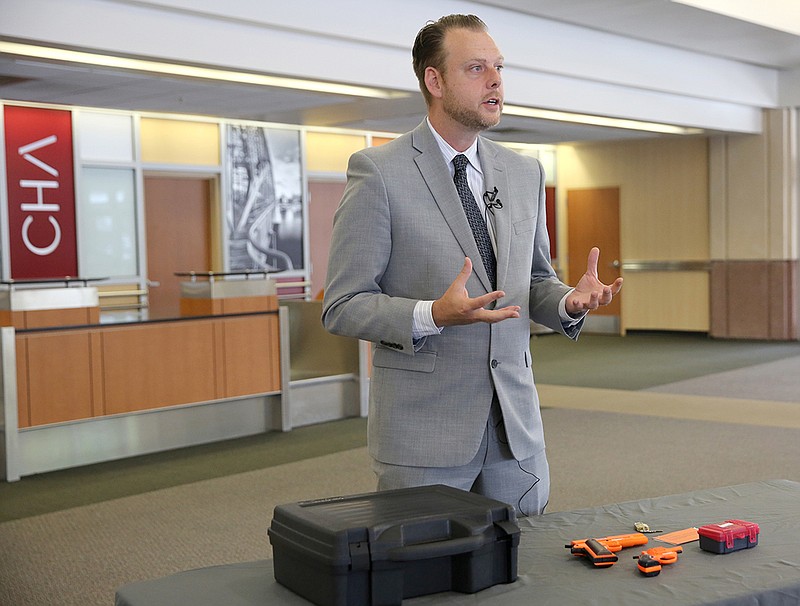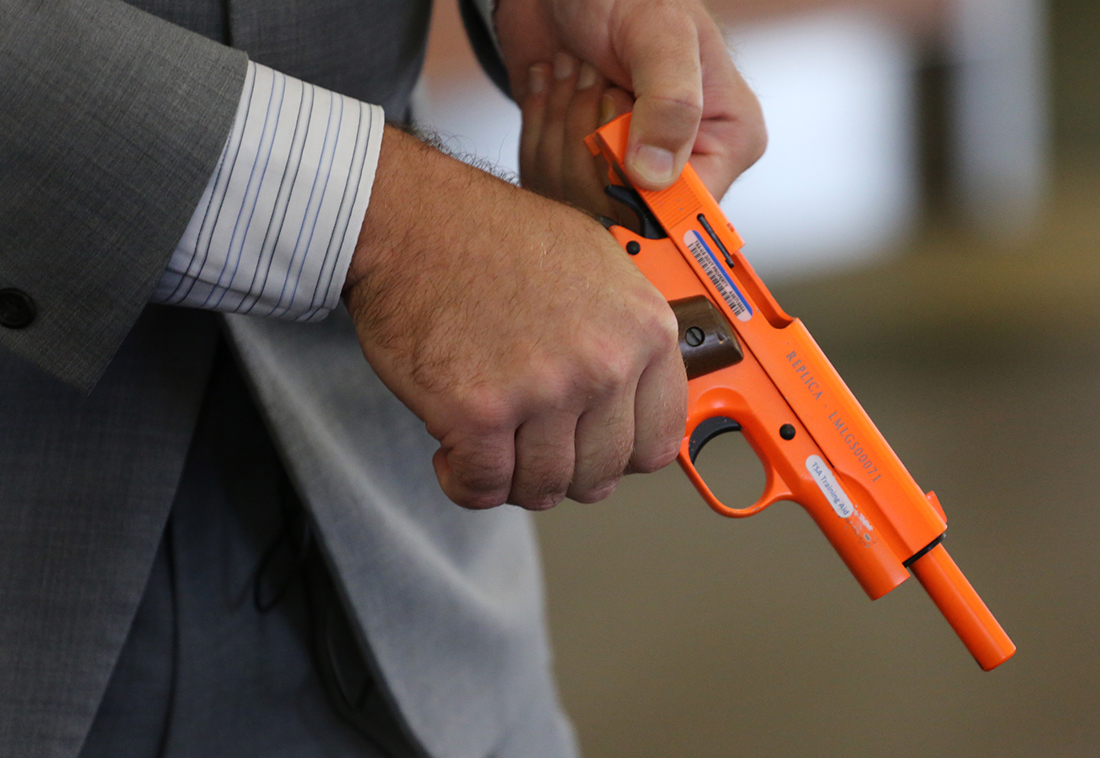 Staff photo by Erin O. Smith /
Mark Howell, the regional spokesperson for the TSA, demonstrates how to unload a handgun during a press briefing about how to legally travel with firearms Wednesday, August 22, 2018 at the Chattanooga Metropolitan Airport in Chattanooga, Tennessee. All firearms must be unloaded before being packed in checked luggage.
Staff photo by Erin O. Smith /
Mark Howell, the regional spokesperson for the TSA, demonstrates how to unload a handgun during a press briefing about how to legally travel with firearms Wednesday, August 22, 2018 at the Chattanooga Metropolitan Airport in Chattanooga, Tennessee. All firearms must be unloaded before being packed in checked luggage.Traveling with firearms
Declare each firearm when checking baggage. Ask your airline about limitations or fees that may apply.Firearms must be unloaded and locked in a hard-sided container and transported as checked baggage only.Only the passenger should retain the key or combination to the lock.Firearm parts, including magazines, clips, bolts and firing pins, are prohibited in carry-on baggage, but may be transported in checked baggage.Replica firearms, including firearm replicas that are toys, may be transported in checked baggage only.Rifle scopes are permitted in carry-on and checked baggage.Traveling with ammunitionAmmunition is prohibited in carry-on baggage, but may be transported in checked baggage.Firearm magazines and ammunition clips, whether loaded or empty, must be securely boxed or included within a hard-sided case containing an unloaded firearm.Small arms ammunition, including ammunition not exceeding .75 caliber and shotgun shells of any gauge, may be carried in the same hard-sided case as the firearm.Source: Transportation Security Administration
With more and more guns being found at airport checkpoints, officials are reminding flyers of how to legally travel with firearms.
The number of firearms discovered at airport check-ins nationwide has seen a steady increase over the past decade, from 803 in 2007 to 3,957 in 2017, according to the Department of Homeland Security website, and 2018 already has seen more than 2,700, Transportation Security Administration regional spokesman Mark Howell said.
In Chattanooga, four firearms have been found so far this year, most recently on July 26. Last year's total was 10.
So what happens if you bring a firearm to the checkpoint? Well, the first thing TSA officials do is stop operations in that lane.
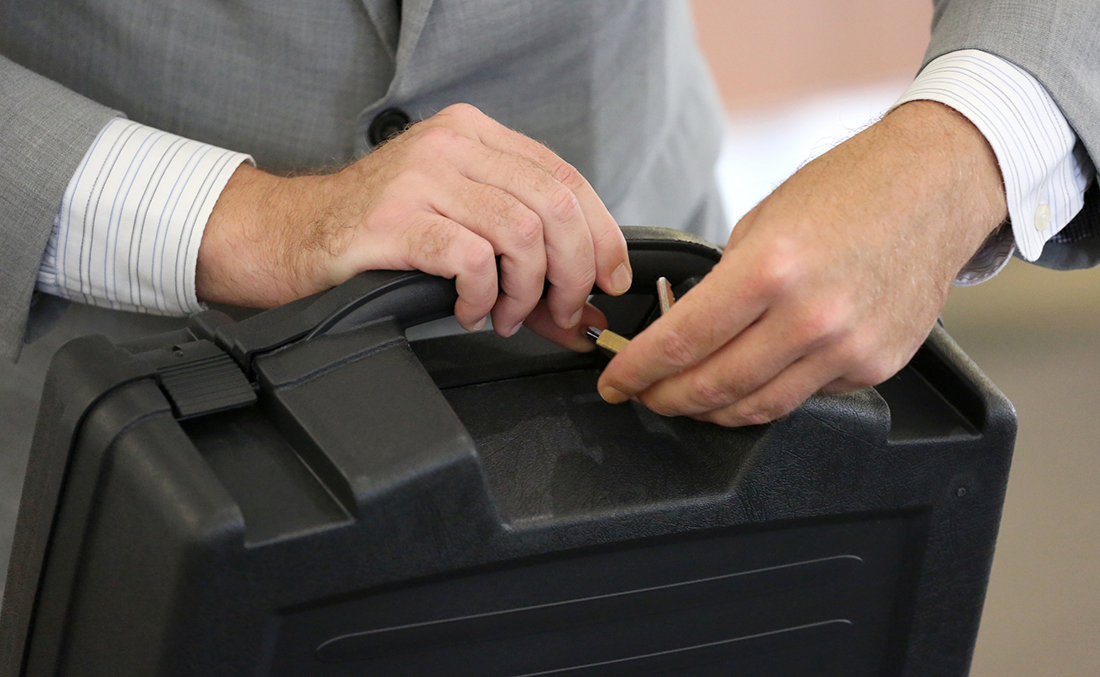 Staff photo by Erin O. Smith /
Mark Howell, the regional spokesperson for the TSA, describes the type of locks individuals may use to lock their firearm cases in order to legally travel with firearms during a press briefing Wednesday, August 22, 2018 at the Chattanooga Metropolitan Airport in Chattanooga, Tennessee. Howell said the individual should use a lock that only he or she can open, and that it shouldn't be a TSA approved lock.
Staff photo by Erin O. Smith /
Mark Howell, the regional spokesperson for the TSA, describes the type of locks individuals may use to lock their firearm cases in order to legally travel with firearms during a press briefing Wednesday, August 22, 2018 at the Chattanooga Metropolitan Airport in Chattanooga, Tennessee. Howell said the individual should use a lock that only he or she can open, and that it shouldn't be a TSA approved lock."Most of the time when we find a firearm at the checkpoint, the excuse we get is, 'Oops, I forgot it was in my bag,'" Howell said. "And 90 percent of the time, the firearm is loaded."
For safety reasons, law enforcement will be called to remove the gun, Howell said. The airport police officer on duty will determine how to proceed at his discretion, Chattanooga Metropolitan Airport spokesman Albert Waterhouse said.
The officer may criminally charge the offender for illegally attempting to carry a weapon onto a commercial air carrier, write the offender a citation to appear in court and possibly face a fine, or write the offender a warning citation.
"After that is all said and done, TSA is going to issue a civil penalty, and that can hit you pretty hard in the wallet; it's up to $13,000 for bringing that firearm to the checkpoint," Howell said.
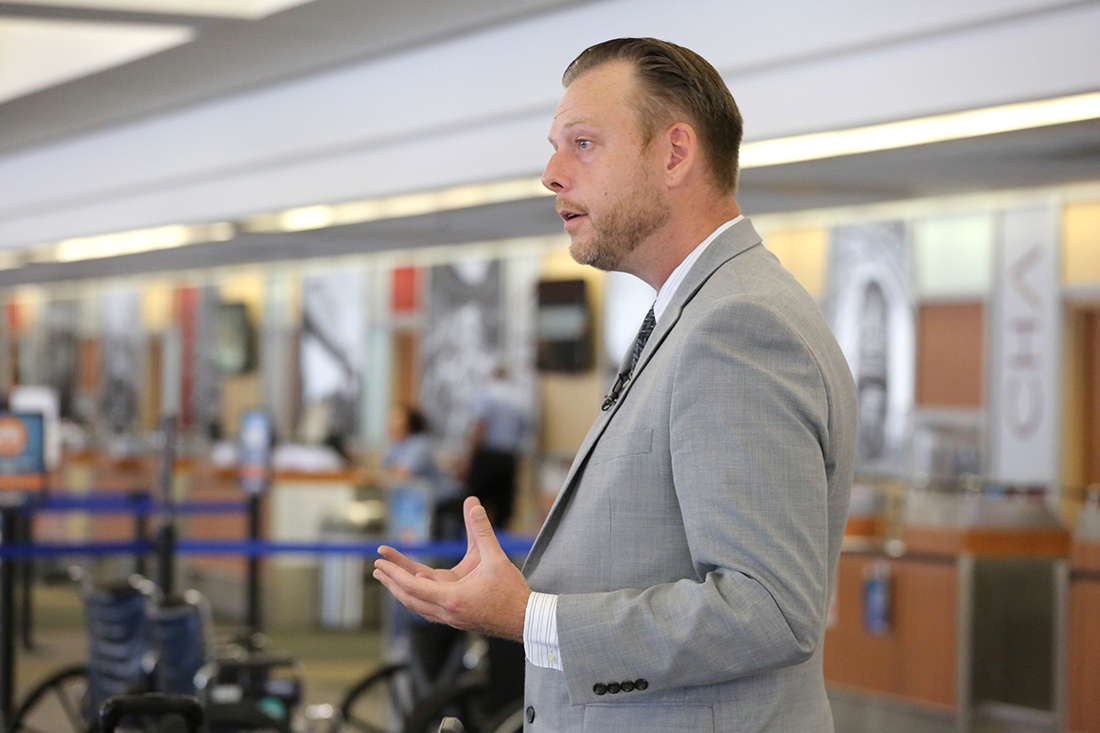 Staff photo by Erin O. Smith /
Mark Howell, the regional spokesperson for the TSA, talks about the process of transporting personal firearms on flights during a press briefing Wednesday, August 22, 2018 at the Chattanooga Metropolitan Airport in Chattanooga, Tennessee. Firearms are allowed on flights as long as they are packed properly in checked luggage, which is not accessible during the flight.
Staff photo by Erin O. Smith /
Mark Howell, the regional spokesperson for the TSA, talks about the process of transporting personal firearms on flights during a press briefing Wednesday, August 22, 2018 at the Chattanooga Metropolitan Airport in Chattanooga, Tennessee. Firearms are allowed on flights as long as they are packed properly in checked luggage, which is not accessible during the flight.But that doesn't mean you can't bring your firearm with you when you fly. It just has to be packed properly in a checked bag and not accessible during a flight. You'll also have to keep your license and carry permit with you.
The first thing to do is acquire a hard-sided firearm case, one that can be secured by locks and has padding. Soft-sided cases will not be permitted, Howell said.
Make sure all firearms are completely unloaded and ammunition is stored properly in a secure box and packed in a "steady state," meaning it doesn't move around in the case.
"With most airlines, the ammunition can go in the same box as the firearms, as long as the firearms are not loaded," Howell said.
But it's always a good idea to check individual airlines' policies. Jet Blue, for example, requires ammunition to be packed separately, he said.
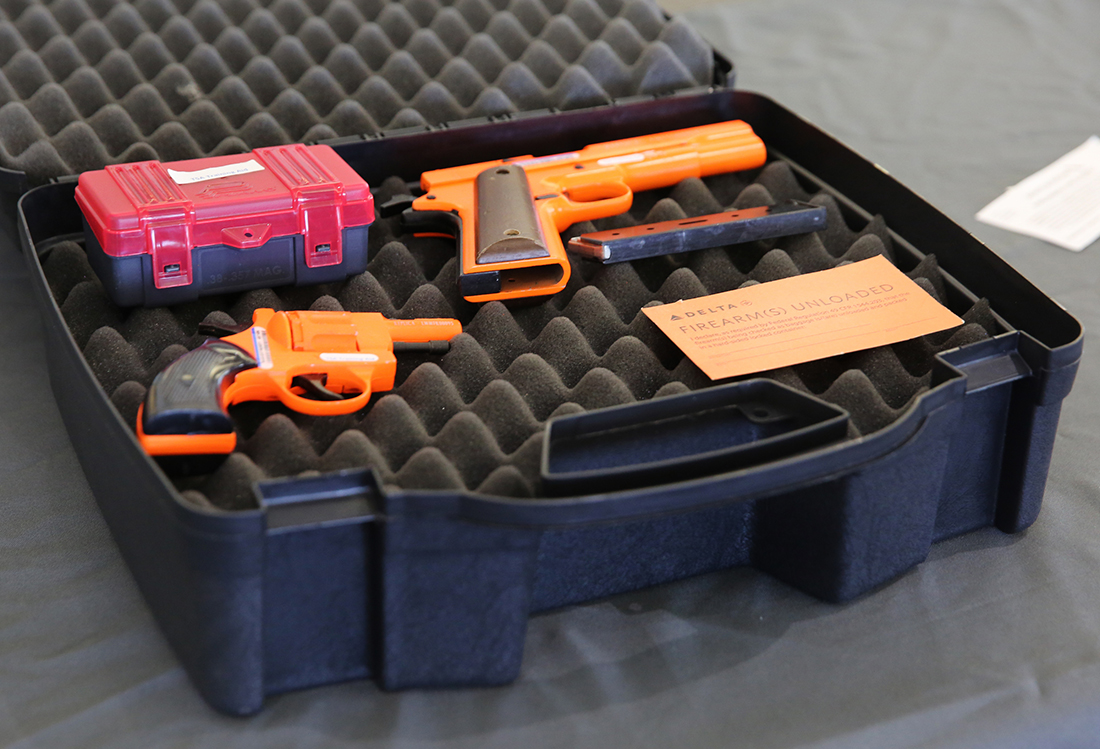 Staff photo by Erin O. Smith /
Replica firearms and ammunition sit in a padded, hard-sided firearm case during a press briefing about legally traveling with firearms Wednesday, August 22, 2018 at the Chattanooga Metropolitan Airport in Chattanooga, Tennessee. Four firearms have been discovered at checkpoints this year at the Chattanooga airport, and 10 were found last year.
Staff photo by Erin O. Smith /
Replica firearms and ammunition sit in a padded, hard-sided firearm case during a press briefing about legally traveling with firearms Wednesday, August 22, 2018 at the Chattanooga Metropolitan Airport in Chattanooga, Tennessee. Four firearms have been discovered at checkpoints this year at the Chattanooga airport, and 10 were found last year.Also, travelers will have to declare the firearms at the ticket counter. It's a card that is placed inside the case and has the owner's contact information and signature acknowledging the transportation of the firearm.
"If a gun comes into security screening that doesn't have a declaration card, we're going to contact the airline and law enforcement," Howell said.
Another tip Howell offered is to tape contact information to the outside of the case.
"That way, if there's a problem with the way that you packed it, we can contact you quickly to make sure that you can fix the problem before your flight," he said.
TSA officials must be able to contact the owner because they are not permitted to open a firearm case, even if it's secured with a TSA-approved lock. And each lockable space must be secured.
"That's one problem we see a lot, is we'll have the long rifle case with just one lock on it, and we can unlatch it and actually pull the gun out of the end of it," Howell said.
Staying in the ticketing area for a few extra minutes is a good idea, too, he said, in case there is an issue with packaging.
"What we don't want you to do is go through security and then get a phone call from us that you have to fix the problem, and then go through security again," he said.
When picking up the case, Howell noted that if it's packed inside a regular suitcase, it'll come out on the baggage carousel. But if it looks like a firearm case, it'll probably be held at the airline's oversized luggage area for security.
Contact staff writer Rosana Hughes at rhughes@timesfreepress.com or 423-757-6327 with tips or story ideas. Follow her on Twitter @HughesRosana.
